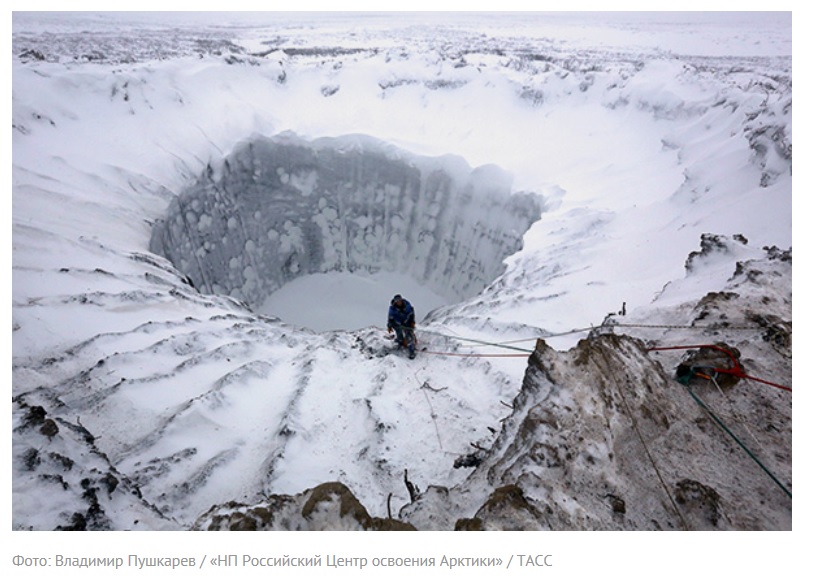December 09, 2016
For the past several years, anomalous lifting of surface that conceals gas bulbs inside and large depressions have been encountered in the northern territories of Russia. All these sites are located in permafrost zones, in areas with high greenhouse gas contents, partly, carbon dioxide, and methane. According to scientists, this gives evidence to general cause of the bulbs and depression. Occurrence of anomalous gas bulbs and depressions is caused by global warming, and more likely, as the time passes the depressions turn into bulbs. The large depression, located between the Karsk Sea shore area and the Mordy-Yakhta River basin, to the south of the Bovanenkovsky gas-condensate deposit, has been studied in more detail. Its diameter is over 60 metres, depth 50 metres, while the walls are almost vertical. A 20 storeyed house would easily be placed in this depression. There is water in the bottom with about 10 metres depth. Depression walls are collapsing due to erosion, thus expanding its diameter. This natural site, encountered in 2014, occurred in a permafrost area, where annual average temperature is not over 7 degree Centigrade. During warm period of the years, the soil cover of 20 m, consisting of clay, turf and ice thaws to a maximum of 1 metre. How was this depression formed here? A group of Russian scientists arranged an expedition to the site to study the reasons of this. Geophysicists drew an opinion that the depression was formed due to effluence of methane at the crossing points of tectonic faults. The geomagnetic data gave this indication. Electromagnetic sounding using the electrical transient method identified a layer of anomalously high specific electrical resistance of sols at 60-80 metre depths, where, most probably, gas hydrates – crystal-like compounds of water and gas are contained.
 Gas-hydrate thaw causes liberation and accumulation of methane under the surface of the Earth in fault areas and form the above anomalous gas bulbs. Gas pressure gradually rises to four bars. In addition, gas warms up top layers of soils – the temperature inside the bulb may reach plus 20-30 degree Centigrade. In summer, when the permafrost melts in its top layers, the bulb breaks through. Methane goes into the atmosphere by leaving a void depression in subsoil.
Gas-hydrate thaw causes liberation and accumulation of methane under the surface of the Earth in fault areas and form the above anomalous gas bulbs. Gas pressure gradually rises to four bars. In addition, gas warms up top layers of soils – the temperature inside the bulb may reach plus 20-30 degree Centigrade. In summer, when the permafrost melts in its top layers, the bulb breaks through. Methane goes into the atmosphere by leaving a void depression in subsoil.
It is obvious that general warming contributes to this process. According to the data from “Marre-Sale” meteo-station, for the past 14 years, the average annual temperature in Central Yamal area rose by 2,3 degrees, while in 2012, there was a sharp jump of temperature. This was the period, when most active processes that followed thawing of permafrost – thermocarst and thermodenudation were observed. Thermocarst is accumulation of water in non-flowing spaces, formation of underground lakes. Thermodenudation is downslope flowing of excessive water together with rocks. The scientists are of the opinion that the Yamal depression appeared in autumn of 2013, exactly due to sharp rise of temperatures in 2012.
According to assessment of the scientists, a total of about 1,4 thousand Giga-tons of greenhouse gases are accumulated in permafrost zones. About ten per cent of these gases exit to the surface at thawing of the surface. According to a theory, from a certain moment, the process of liberation of methane may serve a cause of Permian Age Ruin – 250 million years ago most of animals of the planet died. Fortunately, gas-hydrates are bedded in deep levels, so the probability of the catastrophe is minute.
Whilst, concentration of methane, currently, in some Arctic areas exceeds background concentration by hundreds times, increase of the number of such areas allows classifying methane effluences as one of the most important factors of global warming. For Russia, over 60 per cent of the territory of which falls on permafrost areas, this is especially vital. Global warming will lead to bogging in vast northern territories, and what is happening with the Yamal depression only confirms this.
In winter, the depression is covered with snow, while in summer it is filled with water. Erosion of walls will extend the depression diameter, and a natural water site – lake will be formed. Are such sites dangerous for northern towns and mining of minerals? Not, yet. The Yamal depression is located in 4 kilometres from the nearest oil and gas field, and the ambient temperatures are very low for destruction of gas hydrates. The main thing to hope is that no such sites will be formed under any deposit, gas pipeline or a settlement and no sharp rise of average annual temperature will occur.
https://lenta.ru/articles/2016/12/09/hole/